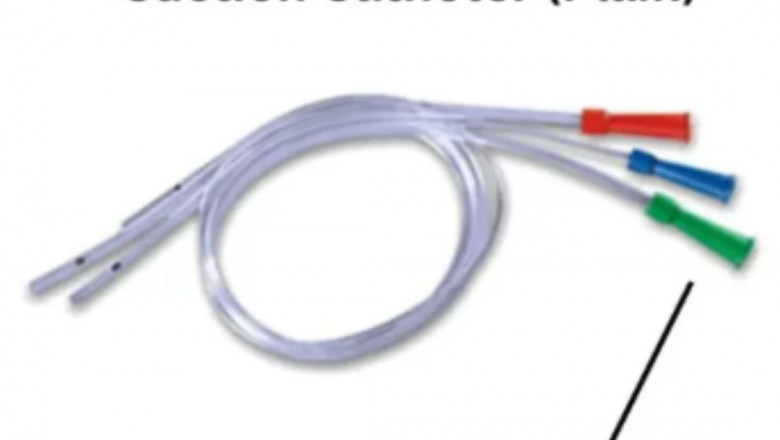views
Introduction
Effective airway clearance is vital in medical care, especially in critical and post-operative settings. A suction catheter plays an important role in maintaining a patent airway by removing secretions, blood, or mucus from the trachea and bronchi. Among its various types, the suction catheter plain is widely used for its simplicity, flexibility, and compatibility with different suction devices.
This article outlines the essential features, benefits, and clinical applications of a catheter for suction, highlighting why product quality and specifications matter in ensuring safe patient care.
What Is a Suction Catheter?
A suction catheter is a flexible, sterile medical tube inserted into a patient’s airway (usually the trachea or bronchial tubes) to extract respiratory secretions. It is commonly used in intensive care units (ICUs), emergency rooms, and surgical setups. The plain suction catheter does not include features like control valves or connectors, offering a straightforward design for manual or machine-assisted suction.
Key Components and Structure
The suction catheter plan generally includes the following:
-
Medical-grade PVC Tube: Non-toxic, kink-resistant, and transparent
-
Distal End: Rounded tip with side eyes for gentle suction without mucosal damage
-
Proximal End: Connects to suction devices or collection containers
-
Color-Coded Connector (Optional): For easy size identification (on some models)
-
Markings: For depth indication during insertion (on certain versions)
Primary Applications of Suction Catheter Tubing
Suction catheter tubing is widely used in various clinical and emergency settings:
-
Airway Suctioning in Intubated Patients
-
Tracheostomy Care
-
Post-operative Mucus Removal
-
Neonatal and Pediatric Respiratory Support
-
Respiratory Therapy in ICUs and emergency care
Features of Plain Suction Catheter
-
Soft, Flexible Material: Reduces trauma and eases insertion
-
Sterile and Disposable: Maintains hygiene and prevents cross-contamination
-
Universal Connector: Fits standard suction equipment
-
Atraumatic Tip: Minimizes irritation during airway suction
-
Smooth Surface: Ensures consistent flow and easy navigation
-
Length Options: Available in multiple lengths and sizes for patient-specific use
Benefits of Using a High-Quality Catheter for Suction
A premium catheter for suction delivers optimal patient safety and clinical efficiency. Key benefits include:
-
Effective Airway Clearance: Removes obstructions that compromise oxygenation
-
Improved Breathing Comfort: Helps reduce dyspnea and enhances ventilation
-
Infection Control: Sterile, single-use catheters lower the risk of respiratory infections
-
Reduced Tissue Damage: Rounded tip and side eyes protect delicate mucosa
-
Device Compatibility: Seamless connection with vacuum regulators and suction machines
How to Use a Suction Tube Catheter: Basic Procedure
-
Wash Hands and Wear Gloves: Maintain aseptic conditions
-
Connect to Suction Source: Ensure a secure fit
-
Insert Gently: Advance the catheter along the airway without force
-
Apply Intermittent Suction: Withdraw the catheter slowly while suctioning
-
Dispose After Use: Follow clinical waste protocols for safety
Note: This is a general overview. Usage should always follow facility protocols and clinical training.
Available Sizes and Customization
The suction catheter plain is available in various sizes—ranging from pediatric to adult (Fr 6 to Fr 18)—to accommodate different patient needs. Lengths typically vary from 37 cm to 56 cm. Some models may offer customization options like:
-
Pre-lubricated variants
-
Color-coded size connectors
-
Option of DEHP-free PVC for sensitive applications
Factors to Consider When Choosing a Suction Catheter
When selecting a suction catheter, consider the following quality indicators:
-
Material Safety: Non-toxic, medical-grade PVC
-
Sterility Assurance: EO sterilized and clearly labeled
-
ISO/CE Certification: Ensures compliance with international quality standards
-
Packaging: Individually packed for hygienic use
-
Manufacturer Reputation: Choose products from trusted sources with consistent quality
Where Are Suction Catheters Commonly Used?
-
Hospitals and Clinics
-
Ambulance and Emergency Medical Services (EMS)
-
Home Healthcare for Tracheostomized Patients
-
Pediatric and Neonatal ICUs
-
Post-operative Recovery Rooms
Importance of Quality in Suction Catheter Tubing
The suction process must be efficient, gentle, and safe. Inferior suction catheter tubing can lead to issues such as:
-
Mucosal injuries
-
Blockages due to poor lumen design
-
Incompatible connectors
-
Non-sterile packaging risking infection
That’s why investing in a high-quality plain suction catheter is essential to support safe respiratory care and avoid complications.
Global Demand and Use
As the need for respiratory interventions rises, especially in aging populations and in intensive care scenarios, the global demand for suction catheters continues to grow. Healthcare providers and facilities require dependable, well-tested products to support patient outcomes.
Conclusion
The suction catheter plain is a critical tool in airway management, offering an efficient, hygienic, and safe solution for secretion removal. Its simplicity and effectiveness make it indispensable in routine and emergency care. To ensure optimal results, always choose a catheter that meets global quality standards and is tailored to the patient's needs.
For more information and detailed specifications, visit GST Corporation Ltd, a trusted name in medical product excellence.






















Comments
0 comment